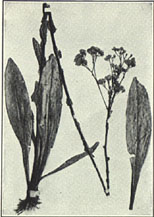Deertongue
Deertongue, also called dog-tongue and vanilla plant (Trilisa odoratissima), is native to the U.S. coastal region from North Carolina to Florida. It is characterized by basal clusters of dog- or deer-tongue shaped leaves followed by a three-to-five-foot central flower stalk with purple flowers in late summer. It inhabits the poor, sandy soil near Carolina Bays or pocosins and flat pine lands and is found as far inland as Sampson and Wayne Counties.
The deciduous leaves of this perennial herb were the focus of its value to people. Deertongue leaves were harvested from June to the first frost, sun dried on blankets, and sold to buyers that baled the dry leaves and in turn sold them to large buying centers. Two of the largest of these centers were in Brunswick, Ga., and Richmond, Va. Most of the dried leaves were then sold to tobacco companies, ground up, and placed in tobacco products to give a pleasant, vanilla-like aroma. Tobacco companies did not make this practice public, but it persisted until at least the 1970s, when supplies of deertongue began dwindling and substitute ingredients were found.
In early homesteads, deertongue leaves were placed in bureaus to impart a pleasant smell to clothing or hung in bundles in rooms to freshen the air. Deertongue also has medicinal properties; Native Americans and the earliest settlers made a tea that was believed to be an all-purpose cure and tonic. Deertongue concoctions were also used as stimulants and sweat-inducing agents.
References:
William S. Justice, C. Ritchie Bell, and Anne H. Lindsey, Wild Flowers of North Carolina (2nd ed., 2005).
Frank A. Montgomery, "Deer Tongue-Unique Carolina Product," Raleigh News and Observer, 18 Sept. 1966.
Additional Resources:
Deer Tongue, Purdue Horticulture: http://www.hort.purdue.edu/newcrop/herbhunters/vanilla.html
Montgomery, Frank A., Jr. "That Mysterious Ingredient 'Deer Tongue.'" Tobacco Reporter. October 1966. 15-17. Tobacco Documents Online. http://tobaccodocuments.org/ti/TIMN0072947-2949.html (accessed June 19, 2013).
"Media Coverage Of "Deer-Tongue": A Chronology." Legacy Tobacco Documents Library. University of California, San Francisco. http://legacy.library.ucsf.edu/tid/fxc72d00 (accessed June 19, 2013).
Image Credit:
Deertongue, Trilisa odoratissima. Image courtesy of Horticulture and Landscape Architecture at Purdue University.
Available from http://www.hort.purdue.edu/newcrop/herbhunters/vanilla.html (accessed August 28, 2012).
1 January 2006 | Bullard, A. J.
